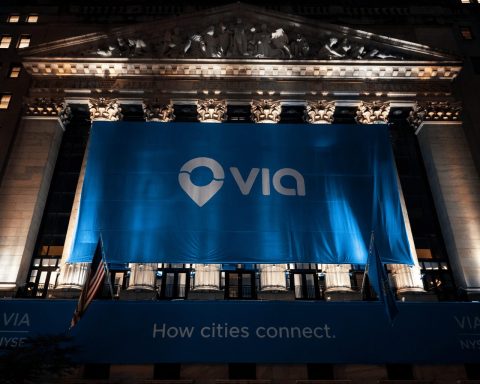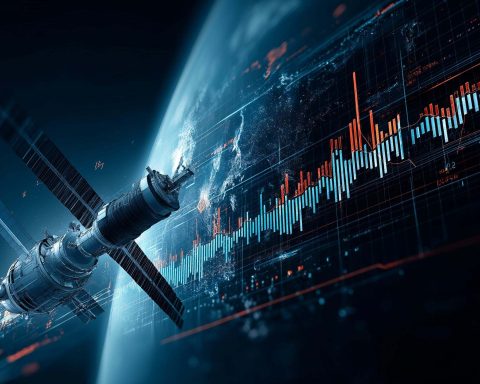- AMD’s Ryzen Threadripper Pro 9995WX workstation processor launched at $11,699 and features 96 cores, 192 threads, a Zen 5 design, and up to 5.4GHz, claiming the title of the world’s fastest CPU.
- Samsung’s 61.44 TB PCIe Gen5 SSD, the largest enterprise drive to date, went on sale for $5,593 (~$0.09/GB) and delivers 14.2 GB/s read and 2.1 GB/s write speeds using QLC flash.
- The FOSSiBOT F107 Pro rugged phone adds “Starlight Night Vision” capable of color photography at 0.0005 lux, powered by a 28,000 mAh battery and MIL-STD-810H durability.
- A GoPro Max 2 prototype leaked showing a 360° camera with evidence the final model will include a built-in screen.
- Apple’s iPhone processors have improved about 385× since 2007, with the late-2025 iPhone 17 Pro expected to push past 500× the original iPhone’s CPU power.
- The U.S. Section 232 chip-import probe is nearing conclusions, with Commerce Secretary Howard Lutnick saying it will wrap in two weeks and that higher tariffs are on the horizon.
- Fractilia’s whitepaper warns that stochastic variability in EUV lithography creates random nanoscale defects at 3nm and 2nm process nodes, delaying volume production and slashing profits.
- SpaceX performed back-to-back Falcon 9 launches within 24 hours, carrying 28 and 24 Starlink satellites and pushing the active fleet above 8,000 satellites for about 6 million users globally, marking SpaceX’s 95th flight of 2025.
- Europe notched a Vega-C return-to-flight on July 25 from Kourou, carrying five satellites including France’s MicroCarb and four Airbus CO3D minisats after a late-2022 failure.
- Russia’s Roscosmos launched Iran’s Nahid-2 telecommunications satellite on July 25 via a Soyuz-2.1b from Vostochny, alongside two Russian research sats and 17 smaller payloads.
Hardware Highlights: Monster CPU and Mega-Storage Deals
World’s Fastest CPU Hits the Market: AMD’s new flagship Ryzen Threadripper Pro 9995WX workstation processor launched for a jaw-dropping $11,699. Built on cutting-edge Zen 5 architecture, this 96-core, 192-thread behemoth boosts up to 5.4GHz [1]. It’s officially the world’s fastest CPU, though its eye-watering price means it’s overkill for all but the most extreme professional workloads. Tech observers note that while the 9995WX delivers record multi-threaded performance, most users would be better off with cheaper 32- or 64-core chips unless they truly need 96 cores of computing muscle.
Samsung’s 61TB SSD Bargain: In storage news, Samsung’s largest SSD to date – a 61.44 TB PCIe Gen5 drive – just went on sale heavily discounted. Normally ~$7,500, it’s now listed for $5,593 (about $0.09 per GB) after promotions [2]. This 2.5-inch enterprise SSD uses QLC flash and a PCIe 5.0 interface to deliver huge capacity for data centers. With 14.2 GB/s read and 2.1 GB/s write speeds, it targets read-intensive workloads. The sub-$6k sale price makes it a remarkable value in the ultra-high-capacity storage class, though it’s still a niche luxury for anyone outside of large IT environments.
Consumer Electronics & Gadgets: Night Vision Phone and GoPro Leak
A Phone That Sees in the Dark: A new rugged smartphone, the FOSSiBOT F107 Pro, is turning heads with its claimed ability to capture full-color images in near-total darkness. Its “Starlight Night Vision” tech can supposedly produce vivid color photos at light levels as low as 0.0005 lux (darker than a moonless night) [3]. The device achieves this through an ultra-sensitive sensor and large-aperture lens that utilize ambient starlight. With a massive 28,000 mAh battery and MIL-STD-810H durability, the F107 Pro is built for extreme outdoor use. While experts are intrigued – “the idea is that it can capture full-color visibility in near-total darkness” [4] – they also caution that real-world results may not match the marketing hype. Still, for field professionals like search-and-rescue teams, a phone that effectively sees in the dark could be a game-changer.
GoPro Max 2 Leaked Prototype: Action cam enthusiasts got an exciting teaser as a prototype of GoPro’s next 360° camera (the Max 2) surfaced online. A unit believed to be a Max 2 prototype appeared for sale on a Chinese marketplace – notably missing its display screen, which tipped off insiders that it’s a test version [5]. According to the leak (first spotted on Reddit and Notebookcheck), the Max 2 will indeed have a built-in screen in the final model [6]. The leaked images also show GoPro’s familiar folding mounting fingers. Industry observers expect GoPro to officially launch the Max 2 soon, likely to compete with rival 360 cams from Insta360 and DJI. If the prototype’s existence is any indication, the GoPro Max 2 is on the verge of debut – welcome news for creators awaiting an update to GoPro’s 2019-era 360 camera.
iPhone Performance 500× Since 2007: In other gadget news, a new analysis highlighted how far smartphone chips have come. Benchmark data reveals Apple’s iPhone processors have improved roughly 385× in performance since 2007, and on current trajectory the upcoming iPhone 17 Pro (late 2025) could push past 500× the original iPhone’s CPU power [7] [8]. In practical terms, tasks that took one minute on the first iPhone would now finish in a fraction of a second. It’s a testament to nearly two decades of rapid mobile silicon advances – all packed into pocket-sized devices.
Semiconductor Industry: Trade Turbulence and Tech Hurdles
U.S. Eyes Tariffs on Chip Imports: Geopolitics loomed over the chip sector as the U.S. government signaled results of a major semiconductor import probe are imminent. Commerce Secretary Howard Lutnick announced that a national security investigation into foreign chip imports (under Section 232) will conclude in two weeks – and “higher tariffs [are] on the horizon,” according to President Trump [9]. The probe, launched in April, is examining whether reliance on overseas semiconductors (especially from Asia) poses a security threat [10]. Its outcome could pave the way for new import duties on chips. Notably, this brewing tariff threat helped prod the EU into broader trade talks with Washington to avert a transatlantic tech trade war [11]. Chipmakers are now bracing for potential disruptions in the global supply chain depending on what the U.S. decides in the coming weeks.
Costly Chipmaking “Quirk” Revealed: Meanwhile, chip engineers are grappling with an obscure technical challenge that’s quietly costing the industry billions. A new whitepaper by semiconductor metrology firm Fractilia warns that “stochastic variability” – essentially random nanoscale pattern defects – has become the biggest hurdle to achieving high yields at advanced 3nm and 2nm process nodes [12]. These randomness-induced imperfections in chip lithography are delaying volume production of next-gen chips and slashing profits. “Stochastic variability is contributing to multibillion-dollar delays in introducing advanced process technology,” explains Fractilia CTO Chris Mack [13]. Traditional process controls can’t fully eliminate these probabilistic defects, often caused by the physics of extreme ultraviolet (EUV) lithography. The report urges new design and measurement approaches to close this “stochastics gap” [14]. In short, as chips shrink to atomic scales, a bit of quantum randomness is wreaking very real havoc on manufacturing economics. Solving it will be key to the future of Moore’s Law.
(On a related note, Samsung did ink a blockbuster $16.5 billion deal this week to fabricate advanced chips for Tesla at Samsung’s upcoming Texas plant – a major win for Samsung’s foundry business, which sent its stock up 6% [15]. The chips are slated for Tesla’s next-gen self-driving computer, highlighting how the EV and semiconductor industries are increasingly intertwining. However, since that project centers on automotive AI chips, we’ll simply mark it as an aside here in our non-AI news roundup.)
Cybersecurity: Ransomware Alerts and a Big-Name Breach
“Interlock” Ransomware Warning: Cyber defenders are on high alert after four major U.S. agencies issued a joint advisory about a stealthy new ransomware operation dubbed “Interlock.” The FBI, CISA, HHS, and MS-ISAC warned that “the escalating threat posed by the Interlock ransomware” is targeting companies, healthcare providers, and critical infrastructure across North America and Europe [16]. Active since late 2024, Interlock uses an unusual playbook – it avoids leaving ransom notes, instead giving victims a code and a dark web URL for negotiations [17]. The gang employs double-extortion, stealing data before encrypting systems, and has hit at least two big health organizations (Ohio’s Kettering Health and dialysis giant DaVita) among others. Officials say Interlock’s tactics include “drive-by” downloads masquerading as Chrome/Edge updates and clever social engineering lures [18]. The alert urges organizations, especially in healthcare, to bolster defenses and backups. It’s another reminder of how ransomware crews continue to evolve – and that hospitals remain favorite targets, with potentially dire consequences.
Dell Hacked – Data Dumped (But “Fake”): Also making cybersecurity headlines, Dell Technologies confirmed a cyberattack by an extortion group called “World Leaks.” The breach hit an isolated Dell customer demo environment earlier in July – not core networks – but the hackers still stole and leaked 1.3 TB of internal files online [19] [20]. The leaked trove contains over 416,000 files, including system configs, scripts, and product-related data [21]. Dell quickly downplayed the incident, stressing that no sensitive customer info was exposed. The demo systems used only “synthetic (fake) data… and non-sensitive information,” the company noted in a statement [22]. In other words, the attackers grabbed a lot of files, but Dell claims it was mostly test data and public datasets, not real private records. World Leaks is a rebranded ransomware outfit that now focuses solely on data theft and extortion (forgoing encryption) – a tactic on the rise as actual ransom payments have declined 35% in the past year [23]. Dell’s stance signals it doesn’t intend to pay; it’s investigating the intrusion and asserting that any “valuable” data claims are overstated. The incident shows even tech giants aren’t immune to breaches, but also how preparation (using fake data in demos) can blunt the impact when hackers do get in.
Software & Internet: Bugs Ground Maps App
Google Maps Transit Bug: Millions depend on Google Maps daily, so a glitch in late July caused quite a stir (and plenty of commuter angst). Users reported that the Maps app kept crashing whenever they searched for public transit directions on Android [24]. A Reddit thread documenting the bug drew many “me too” reports, and Android Police was able to reproduce the crash on at least one device [25]. The issue didn’t affect everyone – some Pixel phone owners saw it, others didn’t – but for those hit, it essentially broke a core Maps feature (no bus/train route planning). “It’s a serious headache…leaving [affected users] unable to plot a route to their destination,” one report noted, while Google remained quiet on the cause or a fix [26] [27]. As a workaround, some found that switching Google Maps into incognito mode stopped the crashes, hinting the bug might be related to account syncing [28]. By July 28, Google acknowledged the problem and began rolling out a patch on the server side. The incident, coming on the heels of a brief Spotify and Google outage a few days prior, underscores how even tech titans can stumble – and how quickly users notice when everyday apps go down.
Space & Aerospace: Rapid Launches, New Alliances, and Satellite Milestones
SpaceX’s Starlink Surge (and Outage): It was a banner weekend for SpaceX, which pulled off a “Starlink doubleheader” – two Falcon 9 launches in under 24 hours – to bolster its satellite internet megaconstellation. On July 26, a Falcon 9 blasted off from Florida with 28 Starlink satellites, followed by a second Falcon 9 from California early July 27 carrying 24 more [29]. Both missions were successful, and both booster rockets (on their 22nd and record-setting 19th flights) landed smoothly for reuse [30]. The back-to-back launches marked SpaceX’s 95th flight of 2025 and brought the active Starlink fleet to over 8,000 satellites in orbit [31] – an unprecedented network scale providing broadband to ~6 million users globally. SpaceX President Gwynne Shotwell touted rocket reuse as key to this frenetic cadence. However, the achievement came just days after a hiccup: on July 24, SpaceX’s Starlink network suffered a rare global outage of about 2½ hours, knocking out service for tens of thousands of users (and even disrupting Ukraine’s frontline communications) [32] [33]. SpaceX attributed the blackout to an internal software error and issued apologies, with outside experts calling it likely Starlink’s longest downtime ever [34]. The system recovered that evening, and SpaceX quickly moved on – launching those 52 new satellites to further expand coverage. The episode sparked fresh discussion about the world’s growing dependence on private satellite constellations and the need for resiliency as critical infrastructure goes orbital.
Europe’s Comeback & New Launchers: Across the Atlantic, Europe notched a success with a much-anticipated return-to-flight of its Vega-C rocket. On July 25, the medium-lift Vega-C launched from Kourou carrying five satellites – including France’s MicroCarb (to map CO₂ sources) and four Airbus-built CO3D imaging minisats – and deployed them all safely [35] [36]. This mission was a relief for Arianespace after a Vega-C failure in late 2022 grounded the rocket; officials hailed it as a “return to form” and a boost for European space science. Meanwhile, Australia was aiming to join the orbital club: startup Gilmour Space prepped the maiden flight of its Eris-1 rocket from Queensland for July 27 [37]. The attempt – which would be Australia’s first-ever homegrown orbital launch – was ultimately scrubbed due to winds, but it highlights the growing number of new players in the launch arena. India also readied a major launch (the NISAR Earth observation mission with NASA) for the following week [38], underscoring how globally busy the launch schedule has become.
Russia Launches Iran’s Satellite: In geopolitics-meets-space news, Russia and Iran teamed up on a satellite launch that has Western analysts raising eyebrows. On July 25, Roscosmos used a Soyuz-2.1b rocket from Vostochny to orbit Iran’s “Nahid-2” telecommunications satellite, alongside two Russian research sats and 17 smaller payloads [39]. Iran’s government celebrated the successful deployment of Nahid-2, calling it a win for domestic space ambitions. To Russia, it was an opportunity to showcase international cooperation outside the Western sphere – essentially cementing Moscow’s space ties with Tehran amid ongoing global tensions [40] [41]. The launch also completed Russia’s own Ionozond ionospheric monitoring constellation [42]. While Iran gets a new commsat in orbit (likely enhancing its telecom infrastructure), observers note that these collaborations help Russia offset isolation by working with partners like Iran and China. Both countries remain excluded from U.S.-led initiatives like NASA’s Artemis Accords for lunar exploration, instead pursuing their parallel lunar base plans. The Soyuz launch of an Iranian satellite is a vivid example of that “space club” schism – and a reminder that the space race now has multiple competing tracks.
(Also noteworthy: NASA quietly inked agreements with Brazil and Canada tied to the Artemis moon program, even as diplomatic talks continued at the U.N. on norms for military activities in space [43] [44]. And space weather forecasters issued a minor geomagnetic storm watch for July 27 due to a recent solar flare, with auroras possibly visible unusually far south [45]. No major impacts were expected, and indeed the weekend passed with beautiful auroral displays and no disruptions [46] [47]. The Sun’s activity is ramping up toward its 2025 solar maximum – keeping satellite operators and power grids on alert, but treating skywatchers to more northern lights.)
Transportation Tech: EVs Tap Tesla’s Chargers (Slowly)
Lucid Joins Tesla’s Charging Network: In the electric vehicle world, another Tesla “walled garden” fell as Lucid Motors announced its luxury EVs can now plug into Tesla’s Supercharger stations – with a catch. Lucid is offering owners of its Lucid Air sedan a new $220 adapter (NACS-to-CCS) that lets them use Tesla Superchargers across North America [48]. This follows Ford, GM, and others adopting Tesla’s NACS charging port standard, making Tesla’s vast fast-charger network increasingly open to non-Tesla cars. However, Lucid Air drivers connecting via the adapter will charge at only 50 kW speeds – far below the Air’s 300 kW native capability – due to voltage limitations when using Tesla’s 400V stations [49]. In practice, that means very slow charging for Lucid owners (likely over an hour for a decent top-up). The company frames it as giving customers more flexibility despite the throttling. All Lucid Airs already have built-in 900V DC fast charging on CCS stations; the adapter simply adds access to thousands more locations, albeit at a turtle’s pace. EV analysts note this illustrates the broader industry shift toward Tesla’s charging ecosystem – even a startup once seen as a Tesla rival now wants in – but also the technical mismatches that can arise. For Tesla, it’s another small victory in making NACS the de facto U.S. charging standard. For Lucid drivers, it’s a nice emergency option, but not a replacement for blazing-fast 350 kW CCS chargers (where available). As one auto tech editor quipped, “Lucid owners can use Superchargers now – as long as they don’t mind charging at one-sixth the speed” [50]. Still, with EV road trip charging infrastructure so critical, even slow juice at a Tesla station is better than none if you’re in a pinch.
(In other transport news, Volkswagen’s Audi division cut its sales forecast, blaming U.S. import tariffs and restructuring costs, in a sign of how trade policies are hitting automakers [51]. And Tesla quietly launched a cheaper Model Y in the U.S. to bolster demand, while confirming it won’t offer the long-promised range extender for the Cybertruck – Tesla is betting its charging network (see above) makes that unnecessary.)
Telecom & Connectivity: 5G Ambitions and Satellite Moves
Morocco’s $8 Billion 5G Rollout: Major telecom infrastructure plans are underway in North Africa – Morocco announced a massive MAD 80 billion (~$8 billion) investment to deploy 5G nationwide by the end of 2025 [52]. The first phase will light up 5G in several big cities, aiming to cover 85% of Morocco’s population by 2030 [53]. With 57 million mobile subscribers (90% Internet penetration) in the country [54], demand for faster connectivity is high. The government is also mapping rural dead zones so it can extend coverage to underserved areas and “bridge coverage gaps” over time [55]. This 5G push comes as Morocco prepares to host the Africa Cup of Nations and even some FIFA World Cup matches in 2030, events that typically drive network upgrades. The hefty investment underscores how emerging economies are prioritizing mobile broadband as critical infrastructure. Morocco joins a wave of countries racing to build out 5G, not just in urban centers but eventually to remote villages – bringing next-gen wireless to as many people as possible.
Satellite Internet Competition Heats Up: On the connectivity frontiers, the rivalry between SpaceX’s Starlink and Amazon’s upcoming Project Kuiper is escalating. SpaceX’s recent launches put its satellite fleet well above 8,000 in orbit [56], and the company just rolled out a Direct-to-Cell satellite texting service with T-Mobile to eliminate mobile dead zones [57]. Not to be outdone, Amazon confirmed a new $140 million satellite processing facility at NASA’s Kennedy Space Center to mass-produce Kuiper satellites, capable of integrating 100+ satellites per month to fast-track its planned 3,200-satellite constellation [58] [59]. Amazon’s first test satellites launched earlier this year, and it aims to begin service by 2026. OneWeb (now merged with Eutelsat) also neared completion of its initial 618-satellite network and is developing next-gen sats with higher speeds and laser links [60]. Analysts say having multiple megaconstellations (Starlink, Kuiper, OneWeb, etc.) could improve global coverage and resilience – but also raises concerns about orbital crowding and debris. Regulators are now working on new “space traffic rules” as low-Earth orbit gets increasingly congested [61]. For consumers, the takeaway is that space-based broadband options will soon multiply, potentially driving prices down. From a telecom perspective, the line between satellites and terrestrial networks is blurring, with partnerships (and competition) forming to connect the unconnected. The next decade of internet growth may very well be overhead – requiring both technological coordination and careful governance to keep the connections flowing smoothly.
Emerging Tech & Science: Self-Healing Batteries and Quantum Leaps
EV Batteries That Heal Themselves: European researchers are tackling one of electric vehicles’ biggest limitations – battery longevity – with a futuristic solution: self-repairing batteries. Under a new EU-funded project called PHOENIX, scientists from several countries are developing lithium-ion batteries that can detect internal damage and fix themselves on the fly [62]. The goal is to dramatically extend EV battery lifespans (potentially doubling them) and improve safety, while reducing reliance on mining new raw materials [63]. “The idea is to increase battery lifetime and reduce its carbon footprint because the same battery can repair itself so that fewer resources are needed overall,” explains Dr. Johannes Ziegler of Fraunhofer Institute, one of the lead materials scientists [64]. How would it work? The team is embedding tiny sensors in battery cells to monitor for problems (like micro-cracks, dendrites, or capacity loss) and trigger targeted “healing” mechanisms – for example, applying heat or pressure to reconstitute damaged electrode structures [65] [66]. Some experimental approaches even use magnetic fields to break up metallic dendrites that form during charging [67]. It sounds like science fiction, but early prototypes are in the lab now. If successful, self-healing batteries could make future EVs safer, longer-lasting, and more sustainable – a “rise from the ashes” innovation aptly named after the mythical Phoenix. While real-world deployment is likely years off, the project reflects a broader trend of “smart” batteries that manage themselves, which could revolutionize energy storage well beyond cars (think smartphones that don’t wear out after a few years). The EU sees enough promise here to invest heavily, tying it to climate goals (all new cars sold from 2035 must be zero-emission). It’s a moonshot, but one that could pay enormous dividends: longer-range EVs, less e-waste, and lower costs over a vehicle’s life. As Dr. Ziegler put it, prolonging battery life is exciting because “it is all about bringing the parts together” – materials science, sensors, and engineering – to create a truly resilient power source [68].
Quantum Computing Breakthrough: Finally, in the realm of cutting-edge computing, researchers in the Netherlands achieved a milestone toward modular quantum computers. A team at TU Delft demonstrated the first-ever quantum teleportation of a logic gate (a CNOT gate) on a silicon photonic chip, effectively performing a quantum operation between qubits with no direct physical link [69]. In plain language, they “teleported” quantum data across a chip using entangled photons – “a significant step… enabling remote quantum operations… and paving the way for scalable, modular quantum computers,” the study noted [70]. This is important because one of the big challenges in quantum computing is connecting lots of qubits without noise or errors. Teleporting quantum gates means separate clusters of qubits could operate together as one, even if they’re on different chips, by leveraging entanglement and classical communication. The Delft experiment achieved a 93% fidelity for the teleported gate, an impressively high accuracy [71]. They also entangled four qubits remotely with ~86% fidelity [72]. While those numbers must improve, it’s proof of concept that distributed quantum processing can work. Experts say this could eventually allow quantum systems to be scaled up by linking many smaller modules – much like multi-core classical processors – rather than forcing all qubits onto one fragile chip. It’s one more leap on the long road to practical quantum computers that can solve intractable problems. And notably, it was done with photonics on silicon, hinting at a future of quantum devices that integrate with existing chip tech. The march of progress in quantum tech may be incremental, but each breakthrough – like teleporting a quantum gate – is unlocking new possibilities for the computers of tomorrow.
Sources: Major news outlets and expert analysis from July 27–28, 2025 were used in compiling this report, including TechRadar [73] [74], Reuters [75] [76], SpacePolicyOnline/TS2 [77] [78], eSecurityPlanet [79] [80], and others as cited above. Each link offers additional details on these developments for those interested in further reading. All emphasis here is on non-AI-related tech happenings to keep you in the know on hardware, software, science and beyond without the AI hype. From record-smashing CPUs and self-healing batteries to satellite showdowns and ransomware fights – the tech world certainly didn’t slow down this past weekend, and neither did we in bringing you the highlights.
References
1. www.techradar.com, 2. www.techradar.com, 3. www.techradar.com, 4. www.techradar.com, 5. www.techradar.com, 6. www.techradar.com, 7. www.techradar.com, 8. www.techradar.com, 9. www.reuters.com, 10. www.reuters.com, 11. www.reuters.com, 12. www.techradar.com, 13. www.techradar.com, 14. www.techradar.com, 15. www.reuters.com, 16. www.esecurityplanet.com, 17. www.esecurityplanet.com, 18. www.esecurityplanet.com, 19. www.esecurityplanet.com, 20. www.esecurityplanet.com, 21. www.esecurityplanet.com, 22. www.esecurityplanet.com, 23. www.esecurityplanet.com, 24. www.techradar.com, 25. www.techradar.com, 26. www.techradar.com, 27. www.techradar.com, 28. www.techradar.com, 29. ts2.tech, 30. ts2.tech, 31. ts2.tech, 32. ts2.tech, 33. ts2.tech, 34. ts2.tech, 35. ts2.tech, 36. ts2.tech, 37. ts2.tech, 38. ts2.tech, 39. ts2.tech, 40. ts2.tech, 41. ts2.tech, 42. ts2.tech, 43. ts2.tech, 44. ts2.tech, 45. ts2.tech, 46. ts2.tech, 47. ts2.tech, 48. www.techradar.com, 49. www.techradar.com, 50. www.techradar.com, 51. www.reuters.com, 52. www.agbi.com, 53. www.agbi.com, 54. www.agbi.com, 55. www.agbi.com, 56. ts2.tech, 57. ts2.tech, 58. ts2.tech, 59. ts2.tech, 60. ts2.tech, 61. ts2.tech, 62. moderndiplomacy.eu, 63. moderndiplomacy.eu, 64. moderndiplomacy.eu, 65. moderndiplomacy.eu, 66. moderndiplomacy.eu, 67. moderndiplomacy.eu, 68. moderndiplomacy.eu, 69. quantumzeitgeist.com, 70. quantumzeitgeist.com, 71. quantumzeitgeist.com, 72. quantumzeitgeist.com, 73. www.techradar.com, 74. www.techradar.com, 75. www.reuters.com, 76. www.techradar.com, 77. ts2.tech, 78. ts2.tech, 79. www.esecurityplanet.com, 80. www.esecurityplanet.com










